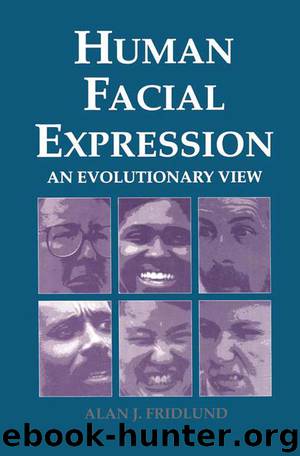Human Facial Expression by Fridlund Alan J

Author:Fridlund, Alan J. [FRIDLUND, ALAN J.]
Language: eng
Format: epub
ISBN: 978-1-4832-8851-2
Publisher: Elsevier Science
Published: 1994-03-14T16:00:00+00:00
A PARTIAL HISTORY
My view of the history of this topic is somewhat different than that usually presented. Most recent articles on facial expression begin, not with Aristotle, but with Charles Darwin. The history of research on the universality thesis was described by Ekman (1980) in terms of Darwin’s (1872/1965) ideas, challenges to Darwin, the rejection of Darwin, and, finally, “a conclusive answer to one of Darwin’s questions, and an answer in agreement with Darwin’s own conviction. There are some facial expressions of emotion which are universal” (p. 137). In his review, Izard (1971) referred to the universality of facial expressions as “Darwin’s hypothesis” (p. 225). Izard (1971) wrote that some researchers agreed that “Darwin was right,” others that “Darwin was wrong.” Izard (1971) described one major review of the available evidence on facial expressions as “anti-Darwinian” (p. 225).
Darwin was not the originator of the universality thesis. Before Darwin’s book appeared in 1872, facial expressions of emotion were a topic of great interest (Bain, 1855, 1859; Bell, 1806; Duchenne, 1859/1990; Piderit, 1867; Spencer, 1855) and were apparently assumed to be universal. For instance, in a book written before Charles Darwin was born, Bell wrote, “The violent passions mark themselves so distinctly on the countenance, both of man, and of animals, that we are apt in the first instance to consider the movements by which they are indicated, as certain signs or characters provided by nature for the express purpose of intimating the internal emotion; and to suppose that they are interpretedby the observer in consequence of a peculiar and instinctive faculty” (1806, p. 84).
Duchenne de Boulogne (1859/1990) referred explicitly to universality. He attributed facial expression to a creator and wrote that “once this language of facial expression had been created, it sufficed for Him to give all human beings the instinctive faculty of always expressing their sentiments by contracting the same muscles. This rendered the language universal and immutable” (p. 19).
In turn, Duchenne drew on even earlier work, such as that of the artist Le Brun (1702/1982). Nor was Le Brun the originator of the idea of universality. Aristotle’s words quoted at the beginning of this article express an idea that can be found in Greek and Roman writers of antiquity (Evans, 1969). Darwin (1872/1965) drew on the work of his many predecessors (Montgomery, 1985), and stated himself that the universality of facial expression “has often been asserted,” although “without much evidence.” As a first step in his research program, Darwin thus sought evidence for the universality thesis “with all the races of mankind” (pp. 14–15). Still, Darwin’s principal goal was not to establish universality, but to provide an evolutionary rather than creationist account of the origins of facial expressions. In short, the universality thesis predates Darwin by several thousand years. That facial expressions might not be universal appears not to have occurred to most people. Both evolutionists and creationists believed in universality. Universality is a background assumption, a part of common sense, at least in Western cultures. Whether in other cultures is the topic of this chapter.
Download
This site does not store any files on its server. We only index and link to content provided by other sites. Please contact the content providers to delete copyright contents if any and email us, we'll remove relevant links or contents immediately.
The Art of Thinking Clearly by Rolf Dobelli(8842)
Mindhunter: Inside the FBI's Elite Serial Crime Unit by John E. Douglas & Mark Olshaker(7834)
Change Your Questions, Change Your Life by Marilee Adams(6641)
Nudge - Improving Decisions about Health, Wealth, and Happiness by Thaler Sunstein(6633)
Mastermind: How to Think Like Sherlock Holmes by Maria Konnikova(6236)
The Power of Now: A Guide to Spiritual Enlightenment by Eckhart Tolle(4755)
Men In Love by Nancy Friday(4326)
Factfulness: Ten Reasons We're Wrong About the World – and Why Things Are Better Than You Think by Hans Rosling(4022)
The Confidence Code by Katty Kay(3566)
Thinking in Bets by Annie Duke(3531)
Man and His Symbols by Carl Gustav Jung(3315)
Three Women by Lisa Taddeo(2920)
The Worm at the Core by Sheldon Solomon(2917)
Why Buddhism is True by Robert Wright(2827)
Liar's Poker by Michael Lewis(2812)
The Inner Life of Animals by Peter Wohlleben(2766)
Descartes' Error by Antonio Damasio(2731)
The Power of Mindful Learning by Ellen J. Langer(2710)
The Slow Fix: Solve Problems, Work Smarter, and Live Better In a World Addicted to Speed by Carl Honore(2574)
